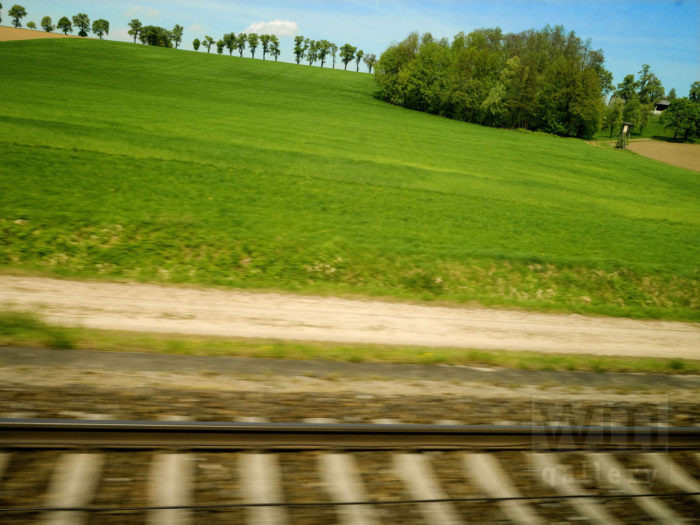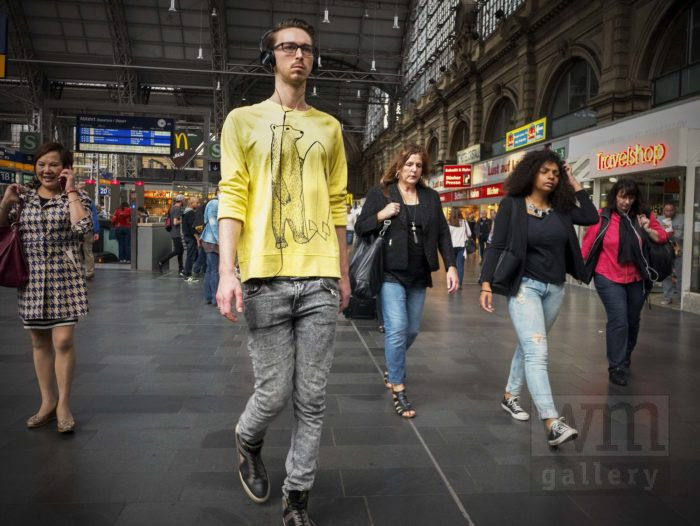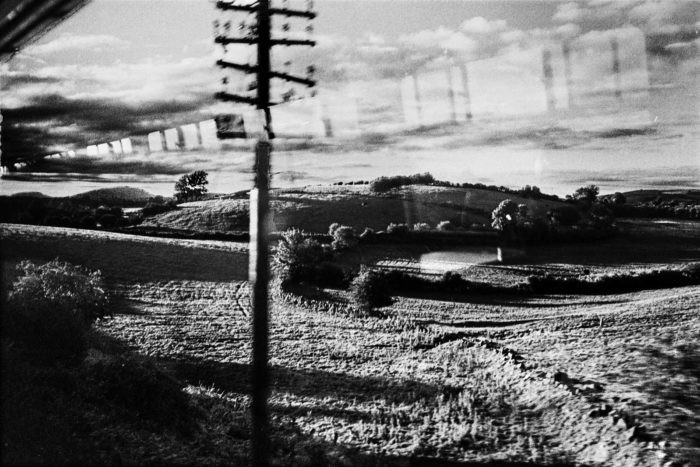“Regarding Iron Lines” Jaap Bijsterbosch 19.01 – 24.02.2024
January 19, 2024 5:00 pmopening Friday 19 January 2024 5-7 PM (17:00-19:00 hrs)
“Omtrent IJzeren Lijnen”
Jaap Bijsterbosch

Jaap Bijsterbosch neemt je met “Omtrent IJzeren Lijnen” mee in de wereld van spoorwegen, treinreizen, treinpassagiers, stations. Een langlopende fotografische obsessie in spoorlijnen als een lang ijzeren lint in het (stads)landschap, in het reizen per trein, het niet genoeg kunnen krijgen van het voorbijflitsend uitzicht. Vaak oog voor het soms vervreemdende van de publieke huiskamer die een treincoupé is en op de treinstations de overgave aan het bijna ritmische geroezemoes.
De af en toe ambigue foto’s zijn gemaakt in een periode van ruim 30 jaar en schetsen behalve een persoonlijke weergave van spoorwegen en treinreizen ook een beeld van de ontwikkeling van de fotograaf Jaap Bijsterbosch. Van analoog (vintage) zwart-wit tot digitaal kleur. Aandacht voor licht, kader, compositie in dienst van het fotografisch verhaal. Soms heel direct, soms observerend, soms voyeuristisch, soms zowat archetypisch.
Op de expositie zullen zowel analoge barietdrukken, hybride zwart-wit prints als volledig digitale kleurenprints te zien zijn, een stukje fotografische geschiedenis.

© Jaap Bijsterbosch
Omtrent IJzeren Lijnen.
“Bijna mijn vroegste jeugdherinnering: Ik zit in het gras en kijk naar de spoorlijn en zie een grote stoomtrein voorbijrijden. De Machinist zwaait. Volgens het verhaal was ik 2 km van huis gelopen en vond mijn vader me na een paar uur ongerust zoeken.
Andere herinnering uit dezelfde tijd: Ik logeer bij mijn oma in Friesland en sta op een paar kussens in mijn ledikantje om net uit het zolderraam naar de spoorlijn achter het huis te kunnen kijken. Elke avond trekt een grote donkergroene puffende stoomlocomotief een lange goederentrein naar Leeuwarden.
In 1967 wordt het perronkaartje in Nederland opgeheven. Als treinenfreak zie ik mijn kans schoon en ga regelmatig op de station perrons van Zwolle kijken. Naar de treinen maar al snel ook naar mensen. Ik verzin verhaaltjes over de in- en uitstappende passagiers. Thuis luister ik naar de Beatles én Stones maar speel ook vaak op de zolder met mijn Märklin modelspoorbaan.
Later word ik fotograaf. De fascinatie voor treinen, spoorlijnen, stations en passagiers is altijd zacht aanwezig om af en toe door te breken in projecten van langere adem. Bij het fotograferen van treinen en spoorwegen ontdek ik steeds meer dat ik er mijn fotografische voorliefdes kwijt kan: landschappen, lichte vervreemding, die soms ondefinieerbare magische momenten tussen mensen in openbare ruimtes. Het spanningsveld tussen openbaar en privé.
Wat ik ook vind zijn die dingen die me als fotograaf van het begin af interesseren. Werking van licht, het op de staart trappen van de tijd, het spitten in de visuele waarneming en daar die elementen uit plukken om een nieuw, misschien wel nooit gebeurd verhaal vast te leggen.
Als opgroeiend kind had ook ik dus een modelspoorwegbaan. Het nabootsen van de treinenloop was leuk, maar vooral het bouwen van het landschap. Die liefde voor het gemaakte landschap kwam later terug in de fotografie. Het vastleggen van spoorweglandschappen, die als een lang ijzeren lint zich door stad en land slingeren. De specifieke spoorwegwerken zoals emplacementen, vakwerkbruggen, bijzondere architectuur. Dat begon allemaal toen ik een werkruimte kreeg naast een spoorbrug, waar elke paar minuten met veel geraas een trein overheen bonkte.
Toen de digitale compact camera op de markt kwam, zag ik mijn kans schoon. Onzichtbaar en onhoorbaar kon/kan ik mensen in de openbare huiskamer die de coupé is observeren en vastleggen. Ik vroeg/vraag eigenlijk nooit om toestemming. Als ik dat doe is de authenticiteit van het moment voorgoed verloren. En is het niet zo dat de trein- & metrocoupé ’s verlengstukken zijn van de openbare ruimte. Al zou je dat bij sommige gedragingen soms niet zeggen.”
Jaap Bijsterbosch (1951) ontwikkelde op zijn 16de zijn eerste film op de zolder van het ouderlijk huis. Hij maakte en maakt zowel foto’s waarin het landschap en de locatie centraal staan, als plaatsen waarin menselijke aanwezigheid en menselijk gedrag de hoofdrol spelen. Het artificiële dorpslandschap in de omgeving van zijn woonplaats Diemen behoort daartoe, maar ook winkelstraten en pleinen in grote steden. Al heel lang voordat de selfies-hype losbarstte, maakte hij zelfportretten. Zijn werk is alom in de wereld geëxposeerd en gepubliceerd, van New York tot in Diemen. Veel van zijn foto´s wonnen nominaties en prijzen bij internationale professionele wedstrijden.
Hij geeft les op de Fotoacademie Amsterdam. Op zijn weblog “Oogenblikjaap” (http://oogenblikjaap.blogspot.com/) doet hij regelmatig verslag van zijn fotografische bevindingen. Hij is lid van de GKfgroep van de beroepsvereniging DuPho.

© Jaap Bijsterbosch
“Regarding Iron Lines”
by
Jaap Bijsterbosch
With “Regarding Iron Lines”, Jaap Bijsterbosch transports you into the world of railways, train journeys, train passengers, stations. A long-running photographic obsession with railway lines as a long iron ribbon in the (city) landscape, with traveling by train, with not being able to get enough of the views that flash by. Often with an eye for the sometimes-alienating aspect of the public living room, which a train compartment ultimately is, and for train stations surrendering to an almost rhythmic buzz.
The occasionally ambiguous photos were taken over a period of more than 30 years and, in addition to providing a personal view of railways and train journeys, they also provide a picture of photographer Jaap Bijsterbosch’s development. From analog (vintage) black and white to digital colour. Attention to light, frame, composition in the service of the photographic story. Sometimes very direct, sometimes observational, sometimes voyeuristic, at times almost archetypal.
The exhibition will feature analogue baryta prints, hybrid black-and-white prints and fully digital colour prints, a piece of photographic history.

© Jaap Bijsterbosch
“Almost my earliest childhood memory: I’m sitting in the grass and looking at the railway line and seeing a big steam train passing by. The Engineer waves. According to the story, I had walked 2 km from home and my father found me after a few hours of frantic searching.
Another memory from the same time: I am staying with my grandmother in Friesland and stand on a few pillows in my crib to be able to look out of the attic window at the railway line behind the house. Every evening a large dark green puffing steam locomotive pulls a long freight train to Leeuwarden.
In 1967, the platform ticket is abolished in the Netherlands. As a train freak, I see my opportunity and regularly visit the station platforms in Zwolle, the town in Holland where I lived. I am drawn to the trains, but soon the people also draw me in. I make up stories about the passengers getting in and out. At home I listen to the Beatles and Stones, but I also often play in the attic with my Märklin model railway.
As time progresses, I am becoming become a photographer. The fascination for trains, railway lines, stations and passengers is always softly present, occasionally breaking through in longer-term photo projects. When photographing trains and railways, I increasingly discover that I can express my photographic preferences there: landscapes, slight alienation, those sometimes-indefinable magical moments between people in public spaces. The tension between the public and the private.
What I also find are those things that have interested me as a photographer from the start. The effect of light, chasing time, digging into visual perception, and picking out those elements to record a new story that may never have happened.
So, as a child growing up, I also had a model railway. Mimicking the running of trains was fun, but building the landscape was even more fun. That love for the created landscape would later be reflected in my photography. Capturing railway landscapes that wind like a long iron ribbon through city and country. Specific railway works such as railway yards, truss bridges, special architecture. It all started when I was given a workspace next to a railway bridge, where a train would bump over it every few minutes.
When the digital compact camera came onto the market, I saw my opportunity. Invisibly and inaudibly, I could observe and capture people in the public living room that the train compartment is. I never ask for permission. If I did, the authenticity of the moment is lost forever. And isn’t it true that the train & metro compartments are extensions of the public space? Although sometimes you wouldn’t say so with some of the behavior.”
Jaap Bijsterbosch (1951) processed his first film in the attic of his parental home when he was 16. He took and still takes photographs in which the landscape and location are central, as well as places in which human presence and human behavior play a central role. This includes the artificial village landscape in the vicinity of his hometown Diemen, but also shopping streets and squares in large cities. He was making self-portraits long before the selfie hype broke out. His work has been exhibited and published worldwide, from New York to Diemen. Many of his photographs have won nominations and awards at international professional competitions.
He teaches at the Photo Academy Amsterdam. He regularly reports on his photographic findings on his weblog “Oogenblikjaap” (http://oogenblikjaap.blogspot.com/). He is an active member of the GKf group of the professional association DuPho.

© Jaap Bijsterbosch
Tags: Jaap Bijsterbosch
